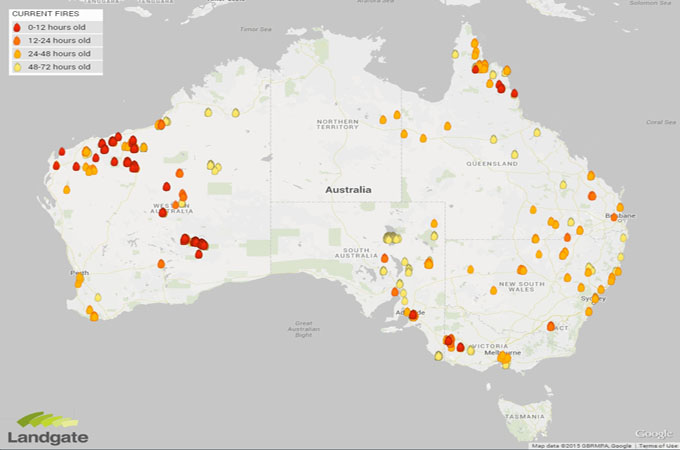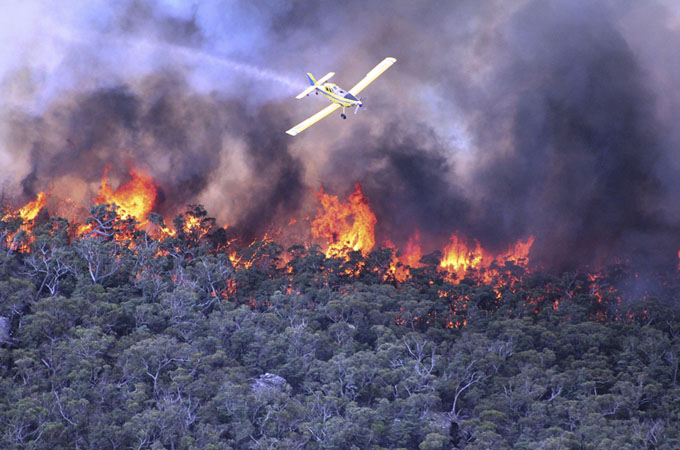Racing to contain Australia’s wildfires
Raging bush fires in South Australia state prompt evacuations and spark questions over the role of climate change.

Adelaide, Australia – Firefighters are in a race against time to bring raging wildfires under control before temperatures begin to rise over the next 48 hours.
The blazes in western Australia have also raised discussion about the effects of climate change in a country governed by politicians who have repeatedly denounced the science warning of possible dire consequences linked to runaway global warming.
Keep reading
list of 4 itemsTurtles swimming to extinction in Malaysia as male hatchlings feel heat
Could shipping containers be the answer to Ghana’s housing crisis?
Thousands protest against over-tourism in Spain’s Canary Islands
Fires that threatened townships in Victoria state have been brought under control since they first started on Friday night, but a blaze in South Australia state continues to burn uncontrolled. The area affected is home to a number of national parks and communities.
About 700 firefighters are battling 11 active fires within the 240-kilometre perimeter.
 |
| A map showing recent Australian wildfires [Landgate] |
So far about 12,500 hectares of scrubland have been affected with 29 people injured since Friday, mostly firefighters tackling the blaze. At least 26 homes were either badly damaged or lost in South Australia with that number expected to rise once the smoke clears and a proper damage assessment can be done.
Though conditions eased over the weekend, the mercury is set to rise again to 38 degrees Celsius on Wednesday.
A spokesperson for the Country Fire Service (CFS) said efforts were now being directed to bring the fire under control before weather conditions possibly change again for the worse.
“We can’t say that we’re comfortable but the weather has been kind and we’re taking advantage of that to bring this fire to a more than rapid conclusion,” the CFS spokesperson said on the usual condition of anonymity as is government policy.
“We are doing as much as we can to extinguish the fire, particularly around its perimeters. That way if we get strong wind gusts, which may or may not occur, we have control of the fire.”
We know we are in a dangerous phase when people are getting fatigued. People have a false sense of security because it appears the worst is over.
South Australia Premier Jay Weatherill, who surveyed the affected area by helicopter on Sunday, warned locals to be vigilant.
“We know we are in a dangerous phase when people are getting fatigued. People have a false sense of security because it appears the worst is over,” he said. “We’ve got a bit of a way to go until we can relax.”
Evacuations
Thousands of people were evacuated from affected areas, many staying with friends and family, or heading to relief stations set up in surrounding communities.
Jamie Lee Hicks, a 24-year-old resident of One Tree Hill town, told Al Jazeera the atmosphere over the weekend was “like a war zone”.
Hicks said it was just a normal Friday night at her parents’ home when they first noticed smoke rising in the distance.
As the night wore on, they watched the fire approach until they could see flames behind trees at the back of their property.
“There was a red glow with so much smoke and it looked really, really close,” said Hicks.
While the flames retreated, the next day smoke and ash filled the sky, making it difficult to breathe and visibility poor.
Hicks said she and her partner didn’t want to take any risks and decided to leave the area, while her father stayed behind.
Authorities, too, were showing caution with roadblocks set up around the fire-zone, preventing many residents from returning to their homes. The Country Fire Service said this is necessary as falling trees mean the roads are dangerous and could lead to people being injured or trapped.
Climate change a culprit?
Australian Greens Party Leader Christine Milne has used the fires to push the federal government to take stronger action on climate change.
When deputy Greens leader Adam Bandt made a similar statement in late 2013 after bush fires tore through New South Wales state, a backlash occurred with commentators accusing Bandt of trying to capitalise politically on the tragedy.
At the time, Prime Minister Tony Abbott responded by dismissing concerns that climate change played a significant role, saying bush fires are a fact of life in Australia.
Since coming to power, Abbott’s government has had a poor record of action on climate change, which federal government ministers refer to as “climate variability”.
 |
| Prime Minister Tony Abbott dismisses concerns that climate change plays a significant role in the prevalence of fires [AP] |
Over the last three months, South Australia has seen well below average rainfall, with temperatures two degrees higher than the long-term trend, according to the Australian Bureau of Meteorology.
However, Fire Ecologist Matthias Boer – from the Hawkesbury Institute for the Environment at the University of Western Sydney – told Al Jazeera that caution needs to be taken when connecting climate change to the frequency and intensity of wildfires.
Scorched earth
While a hot-and-dry period may influence how intense a fire burns once alight, the likelihood of a fire taking hold also depends on how much fuel is available.
“Think of fires as events controlled by a number of limiting factors,” said Boer.
“You need plant material to burn, that’s factor one. That material needs to be dry enough to burn, that’s factor two. You need some kind of ignition, that’s three. Then of course, the hotter, drier and windier the more intense and fast spreading the fire will be.”
“That’s a series of conditions that need to be met and if one of those is missing, fires will be unlikely to take off.”
According to Boer, the importance of these “switches” in limiting fire, and so the long term effect of climate change on fire activity will vary depending on whether the environment is open grassland or forest.
Long term, reduced rainfall from climate change may dry out wooded areas more often and thereby cause more fires. At the same time, it may also reduce the chance of bush fires in arid grassland that dominates the Australian interior, as less rainfall would mean less vegetation and less fuel.
Hot weather, dry-lightning strikes, and 110km/h winds over the weekend stoked fears of a major catastrophe. In February 2009, the devastating “Black Saturday” bush fires in Victoria state killed 173 people and razed more than 2,000 homes in the nation’s worst natural disaster of modern times.